In the diverse ecosystem of Texas, rivers play a vital role. But they’re not just waterways—they’re thriving habitats teeming with wildlife. And among the residents of these dynamic ecosystems, there’s one group that often draws a mixture of fear, respect, and fascination—snakes. Are there snake-infested rivers in Texas? If so, which ones are they, and should you stay away?
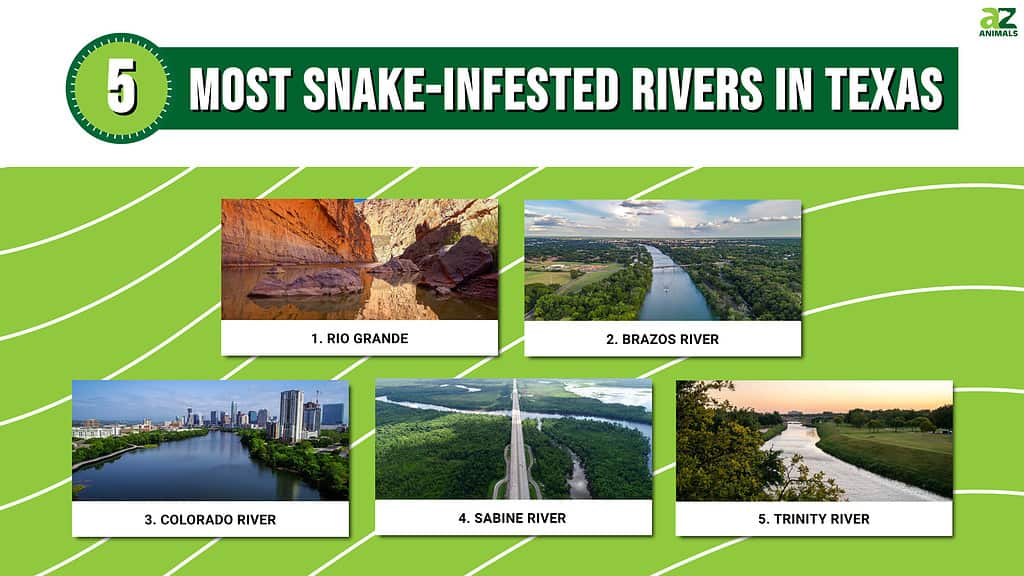
Snakes are an essential part of these environments. They keep the balance in check, controlling pests and serving as prey for larger animals. But beyond their role in the food chain, they’re creatures of intrigue, each species with its unique characteristics and behaviors.
This journey takes us to some of Texas’ most snake-infested rivers. From the venomous varieties to their harmless counterparts, we’ll unveil their habitats, identify the species, and recount tales of snake encounters.
1. Rio Grande
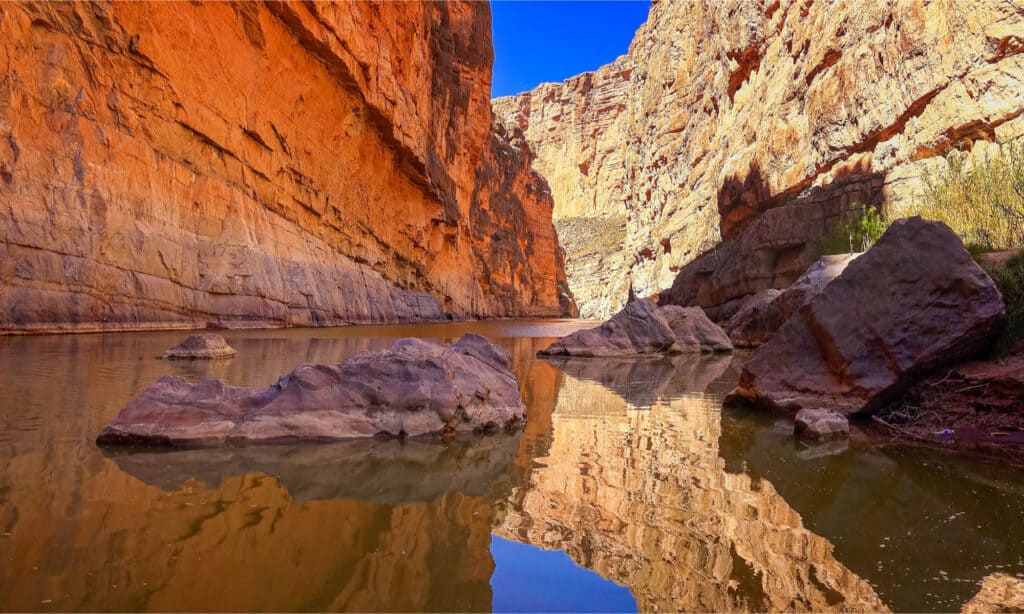
The Rio Grande River flows through Santa Elena Canyon in Big Bend National Park in Texas.
©CrackerClips Stock Media/Shutterstock.com
First on our list is the mighty Rio Grande. You may know it as a geographic staple of the Lone Star State or the famous natural border between Texas and Mexico. But did you also know that it’s a bustling hub for an array of snakes? Let’s dive into the nitty-gritty of this snake haven.
Location and General Description
If you love maps, the Rio Grande is a delight to trace. Originating in the snow-capped peaks of Colorado, it takes a scenic journey through New Mexico before laying claim as a Texas icon. Boasting a length of an impressive 1,896 miles, it ranks as the fourth-longest river system in the U.S.
The Rio Grande is a theater of natural diversity. From the lofty canyons carved over millennia to the tranquil, wide stretches cradling the Texan sun, it paints a landscape like no other. This bountiful habitat is a magnet for a wealth of wildlife, including our slithery neighbors—the snakes.
Types of Snakes Found
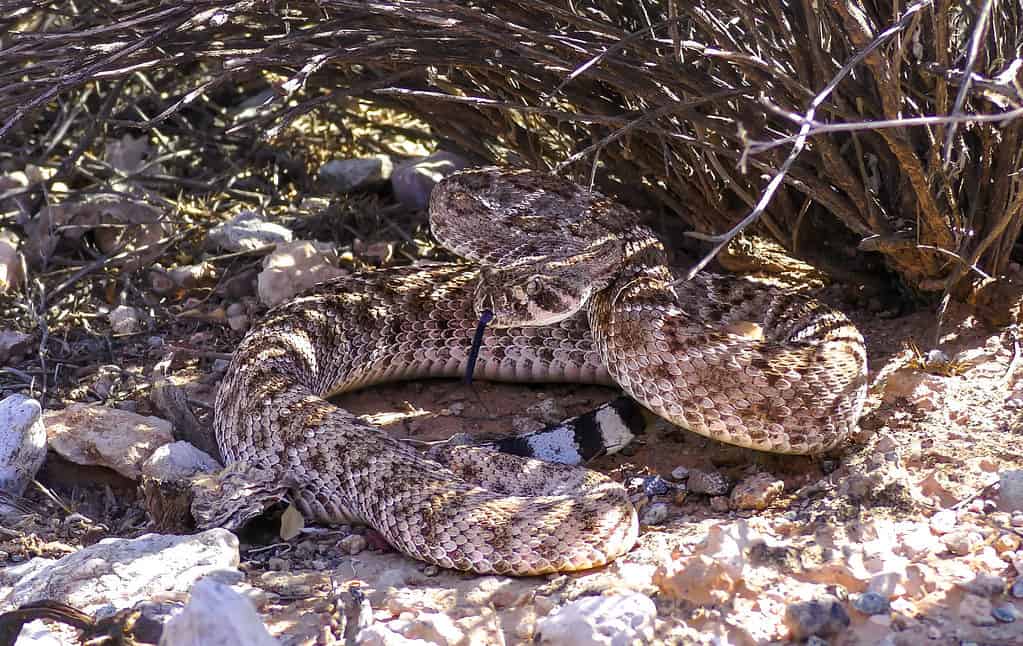
The western diamondback
rattlesnake
is one of the many snakes found near the Rio Grande.
©iStock.com/Banu R
Now, don’t let your imagination run wild. We’re not talking about serpents from an adventure film. The snakes of the Rio Grande, while impressive, are much less fantastical.
The western diamondback rattlesnake, with its signature pattern, is a frequent flyer here. So is the copperhead, recognized by its beautiful coppery-pink hue. The water moccasin (or cottonmouth) also graces these parts. These critters, while venomous, are generally retiring creatures and prefer to avoid run-ins with humans.
Let’s not forget the non-venomous serpents that also call the Rio Grande home. First, there’s the common garter snake, which wears an uncommonly beautiful stripe. Then we have the rough green snake, known to move through the trees and shrubs. These harmless fellows play their part in maintaining the balance of nature, controlling pests, and serving as prey for larger predators.
Reported Encounters and Incidents
Now, the Rio Grande isn’t just a snake-infested river but also a hot spot for nature lovers. Kayakers, hikers, bird watchers, and fishermen frequent the area. And every once in a while, their paths cross with our legless friends.
More often than not, these encounters are fleeting. A snake basking on a warm rock. A tail vanishes into the undergrowth. A quiet rustle amidst the foliage. Yet, there are stories of more exciting encounters where snakes have acted defensively when surprised or feeling threatened. These are far less common and typically occur when the snake feels cornered or endangered.
2. Brazos River
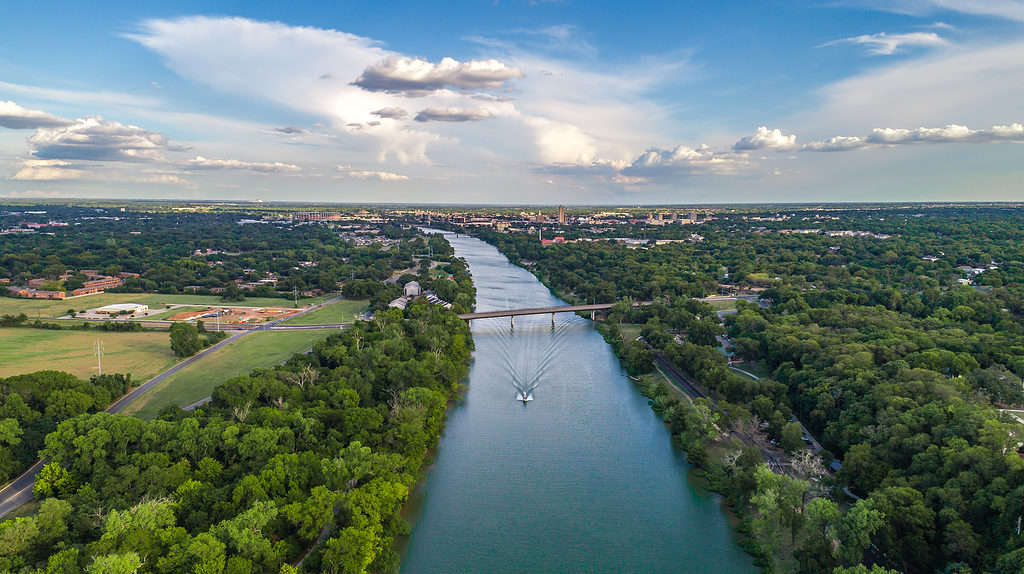
The Brazos River is a beautiful river in Texas, but look out for the reptile population.
©davisdeatonphotography/Shutterstock.com
The next stop on our Texan River tour brings us to the Brazos River. Also known as “The Arms of God” in Spanish, this river spans a whopping 1,280 miles. That’s a lot of space for our slippery, slithery friends, wouldn’t you say?
Location and General Description
Originating from the convergence of the Salt Fork and Double Mountain Fork, the Brazos River winds its way from New Mexico, coursing through the core of Texas, all the way to the Gulf of Mexico. As it flows, it creates diverse habitats:
- Deepwater
- Shallow banks
- Riparian zones
Each spot is a potential home for different species of wildlife, including an array of fascinating snakes.
Types of Snakes Found
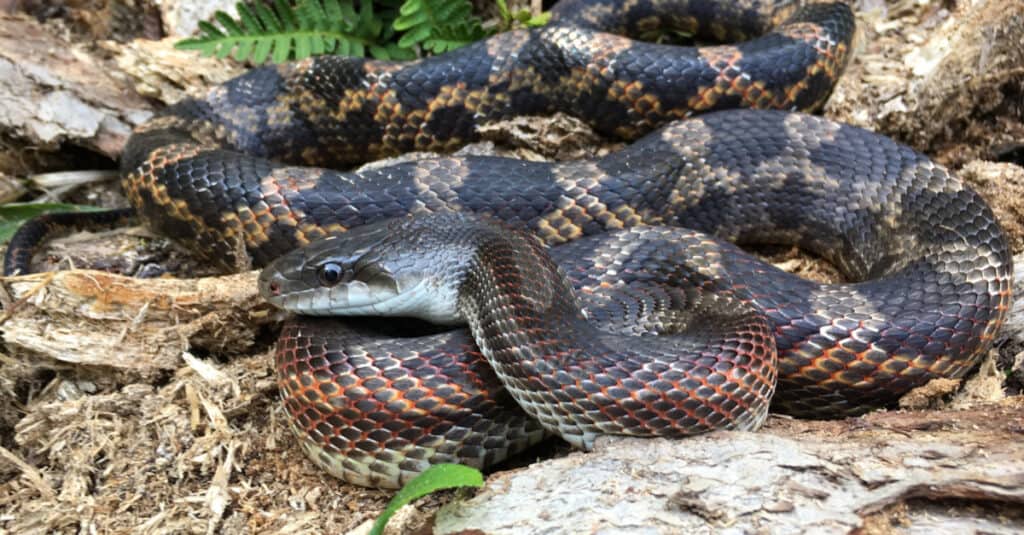
Texas rat snakes are a western rat snake subspecies and often darken with age and lose some of their patterns.
©Joe Farah/Shutterstock.com
Now, let’s talk about the stars of the show. On the snake-infested banks of the Brazos River, you might just cross paths with a broad-banded copperhead, a snake that wears a pattern as stunning as a designer accessory. Then there’s the Texas rat snake, a long fellow with a lovely pattern, who’s quite a good climber and even better at controlling rodent populations.
Can’t forget about the venomous types, though; the western cottonmouth makes an appearance here too. Don’t worry, though; these guys are more into sunning on the riverbanks or slithering in the undergrowth than they are into human interaction.
Reported Encounters and Incidents
Now, what about those who’ve locked eyes with these legless inhabitants? Turns out, there are quite a few stories to tell. But, most of the time, it’s a harmless sighting—a quick flash of scales in the water or the signature slithering movement disappearing into the grass.
But there have been a few incidents when humans and snakes have come a little too close for comfort. It’s usually when the snake is surprised or feels threatened. Remember, we’re visiting their home; it’s only fair they get a little defensive, right?
Despite the occasional hair-raising encounter, the Brazos River remains a favorite among locals and tourists alike. Its stunning landscapes and abundance of wildlife offer a glimpse into Texas’ natural beauty. So, next time you visit, keep an eye out for our slithery friends. They’re an essential part of this vibrant ecosystem and a testament to the diversity and vitality of the Brazos River.
3. Colorado River

The Colorado River in Texas stretches for nearly 900 miles.
©iStock.com/RoschetzkyIstockPhoto
Our next destination takes us to the Colorado River. No, not the one you’re thinking of—this one’s all Texan, through and through. Stretching over 862 miles, the Texas Colorado River is a haven for a host of wildlife. And as you’ve probably guessed by now, that lineup includes our cold-blooded friends, the snakes.
Location and General Description
The Texas Colorado River originates from Dawson County, then weaves its way southeastward through the state until it finally meets the Gulf of Mexico. Its landscapes are as varied as they come: meadows, forests, and hill country, all the way to coastal marshes. This rich tapestry of habitats means a wide range of species calls this river home.
Types of Snakes Found
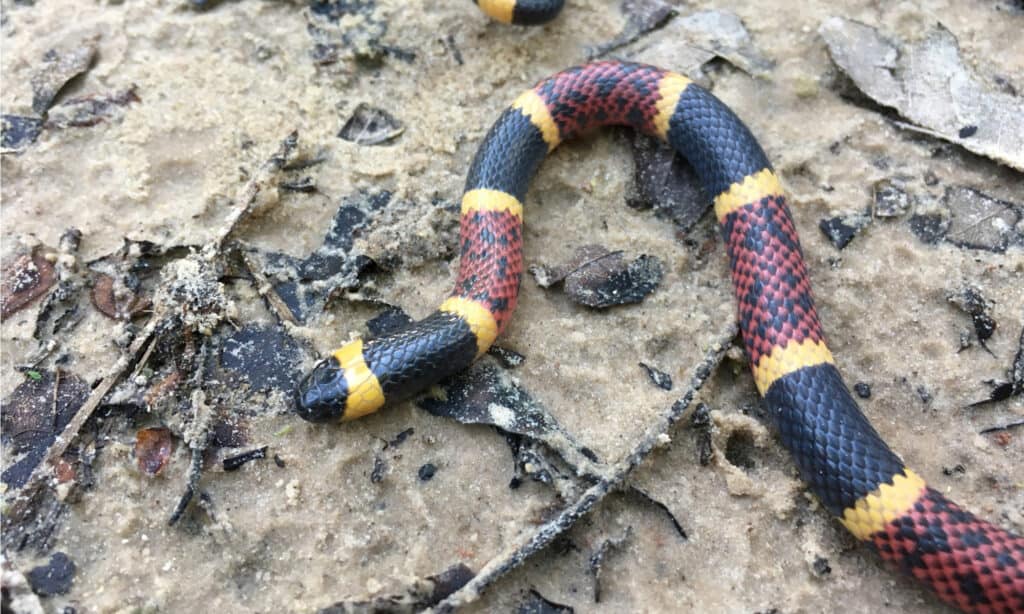
The Texas coral snake is notable for its bands of black, yellow, and red.
©Joe Farah/Shutterstock.com
Who are our river-dwelling serpents? First up, the western diamondback rattlesnake. This big guy is a common sight in these parts. Then there’s the vibrant Texas coral snake, easy to spot with its bold, colorful bands, assuming you happen to spot it while it’s not hiding under leaf litter.
Non-venomous varieties are also present. For example, the diamondback water snake, despite its large size, is actually harmless and often seen basking on branches overhanging the water. You might also spot the checkered pattern of a western ribbon snake as it darts quickly away from any disturbance.
Reported Encounters and Incidents
What’s it like crossing paths with these reptiles? Most of the time, encounters with these snakes are brief, leaving a trail of awe and perhaps a great story to tell. A sudden splash in the water, a fleeting slither in the underbrush, or a sunning snake on a riverbank.
Yet, there have been moments of surprise — heart-stopping instances when snakes and humans have crossed paths a bit too closely. As usual, these rare incidents happen when the snake feels threatened or cornered.
Still, these encounters shouldn’t discourage you from exploring the scenic splendor of the Colorado River. Just remember to tread carefully, respect the wildlife, and keep a safe distance. After all, these serpents play a vital role in maintaining the ecological balance. The next time you visit, don’t forget to marvel at these creatures as they contribute to the thriving, vibrant life along the Colorado River.
4. Sabine River

The Sabine River acts as part of the boundary between Texas and Louisiana
©Lewis Directed Films/Shutterstock.com
Ready for the next adventure? Let’s set our sights on the Sabine River. Known for its swampy charm and bayou beauty, this river has its own unique character. It snakes its way for about 510 miles, providing an ideal home for a variety of Texas critters, including our snake friends.
Location and General Description
The Sabine River is quite the sight, drawing its waters from three forks in northeast Texas before sliding eastward to form part of the Texas-Louisiana border. Eventually, it meanders its way to the Gulf of Mexico. The marshes, swamps, and bottomland hardwood forests found along its course create a unique and diverse habitat that caters to a multitude of wildlife.
Types of Snakes Found
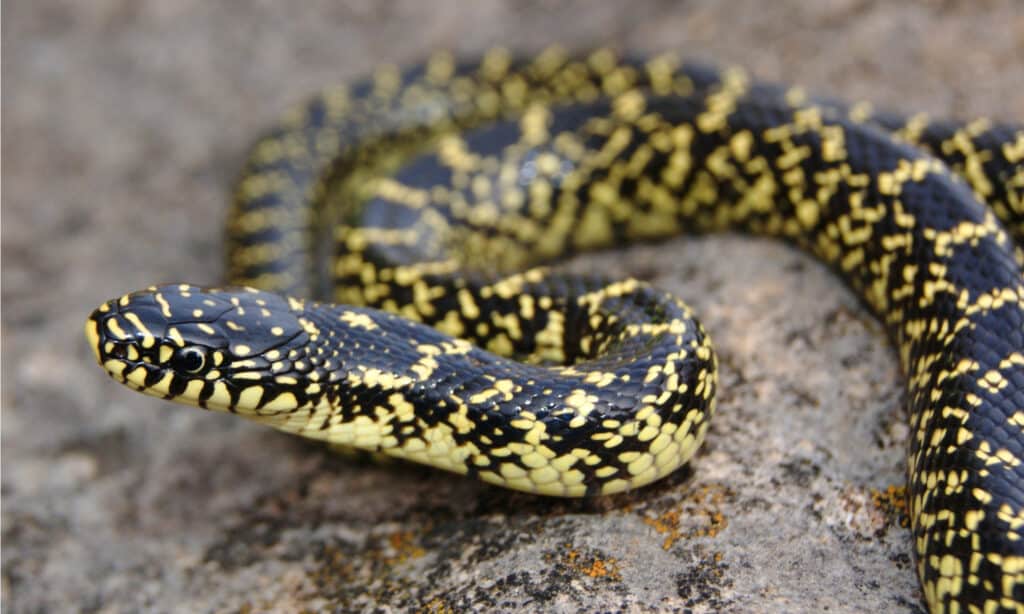
The speckled kingsnake has sleek black scales speckled with yellow-white.
©Matt Jeppson/Shutterstock.com
Alright, let’s meet the slithering locals. The Sabine River is home to both venomous and non-venomous snakes. You might spot a cottonmouth, also known as a water moccasin, basking on a log or swimming through the water. The copperhead, with its distinctive hourglass pattern, also likes to hang out here.
But don’t fret; not all the snakes here carry venom. You might catch a glimpse of the speckled kingsnake, a beautiful creature with a speckled pattern that gives it its name. There’s also the eastern hognose snake, a master of drama that plays dead when threatened.
Reported Encounters and Incidents
What’s it like coming face-to-face with these reptilian river-dwellers? Most encounters are brief and harmless, leaving observers with a sense of fascination and respect for these creatures. You might see a ribbon of movement in the water or a sun-loving snake sprawled out on a riverbank.
However, there have been instances of closer encounters. Remember, these happen when a snake is surprised or feels cornered. But again, we’re in their territory, and they’re just trying to protect themselves.
Exploring the Sabine River offers a unique opportunity to witness the beauty of nature, and that includes our scaly friends. They’re a vital part of this ecosystem, so next time you visit, keep an eye out for them and respect their space. The Sabine River is a reminder of nature’s diversity and the importance of every creature in the grand tapestry of life.
5. Trinity River

The beautiful Trinity River flows through Fort Worth, TX.
©Megan McHatten/Shutterstock.com
Last but not least, on our river tour, we’re venturing into the heart of Texas—the Trinity River. Spanning about 710 miles, it’s the longest river that flows entirely within the state’s borders. Just like our previous stops, the Trinity River is a treasure trove for a variety of wildlife, including, of course, our scaly-skinned associates.
Location and General Description
Drawing from the annals of the state’s history, the Trinity River owes its name to the early Spanish explorer Alonso de León, who christened it “La Santísima Trinidad,” translating to “The Most Holy Trinity.”
The river springs to life from four branches in the North Texas region, converging near Dallas and flowing southeast toward Trinity Bay, an arm of Galveston Bay.
From urban settings to lush forested areas and wetlands, the Trinity River showcases an assortment of habitats. Each of these settings offers a unique stage for diverse forms of wildlife, including an array of intriguing snakes.
Types of Snakes Found
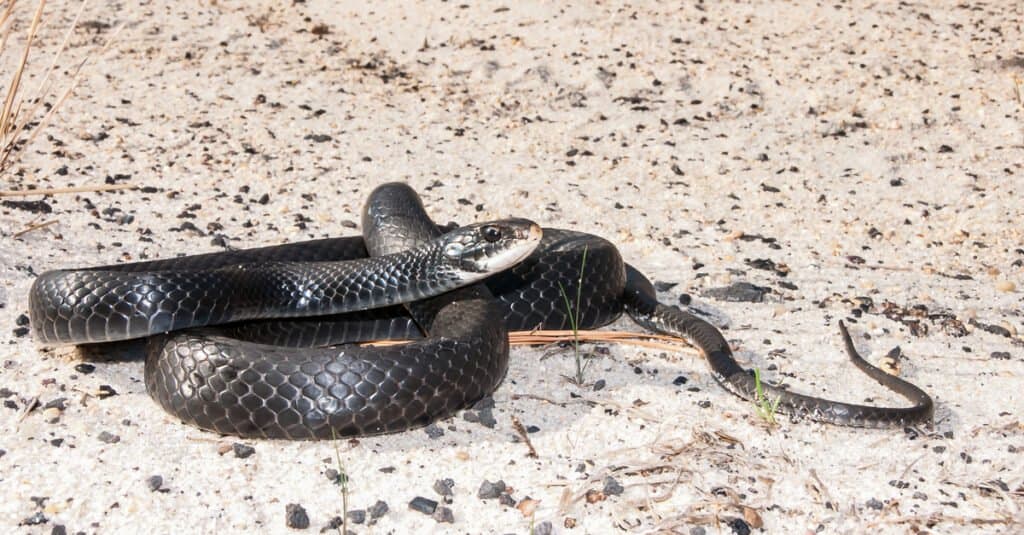
The racer snake is not venomous uses its great speed to escape predators and other threats.
©Jay Ondreicka/Shutterstock.com
Let’s meet the reptilian inhabitants of the Trinity. Starting with the venomous types, we have the western diamondback rattlesnake and the water moccasin, both common sightings near the water’s edge.
But the non-venomous species also make a good show. The North American racer, a sleek, fast mover that’s more likely to flee than fight, is often seen here. And the blotched water snake, a harmless swimmer that’s often mistaken for its venomous counterparts due to its similar appearance.
Reported Encounters and Incidents
What happens when the human world intersects with the snake world? More often than not, it’s a fleeting moment—a quick glimpse of a snake as it slides into the water or a surprise encounter with a snake sunbathing on a warm rock.
However, there are also rare occasions of closer encounters, typically when a snake feels threatened or startled. Always remember, while these experiences can be unnerving, the snakes are simply reacting out of instinct and fear.
Despite these instances, the Trinity River is a must-visit spot in Texas. Not just for the snakes but for the unique display of biodiversity it offers. It’s a testament to the harmony of nature and a showcase of how each organism, including snakes, plays a crucial role in maintaining this balance. So, on your next visit, keep a respectful distance, and take a moment to appreciate these remarkable creatures in their natural habitat.
Key Takeaways
From the winding course of the Rio Grande to the marshy charm of the Sabine River, we’ve journeyed across some of Texas’ most snake-infested rivers. We’ve met a diverse range of slithery residents, each with their unique roles in maintaining the balance of these vibrant ecosystems.
Every reported encounter, from fleeting glimpses to heart-stopping moments of surprise, underscores a crucial fact—these rivers are as much the snakes’ home as they are ours. While the occasional encounter might startle us, remember that these creatures are usually more scared of us than we are of them.
Despite the myths and fears surrounding these reptiles, one thing is clear: snakes are an integral part of Texas’ rich biodiversity. Understanding them isn’t about mitigating fear alone but about appreciating the intricate network of life that flourishes within these rivers.
Summary of The 5 Most Snake-Infested Rivers in Texas in 2024
| # | River | Snakes |
|---|---|---|
| 1 | Rio Grande | Western diamondback rattlesnake, cottonmouth, copperhead, rough green snake, garter snake |
| 2 | Brazos River | Copperhead, Texas rat snake, cottonmouth |
| 3 | Colorado River | Western diamondback rattlesnake, coral snake, diamondback water snake, ribbon snake |
| 4 | Sabine River | Western cottonmouth, copperhead, speckled kingsnake, eastern hognose snake |
| 5 | Trinity River | Western diamondback rattlesnake, water mocassin, North American racer, blotched water snake |
The photo featured at the top of this post is ©
Discover the "Monster" Snake 5X Bigger than an Anaconda
Every day A-Z Animals sends out some of the most incredible facts in the world from our free newsletter. Want to discover the 10 most beautiful snakes in the world, a "snake island" where you're never more than 3 feet from danger, or a "monster" snake 5X larger than an anaconda? Then sign up right now and you'll start receiving our daily newsletter absolutely free.
Thank you for reading! Have some feedback for us? Contact the AZ Animals editorial team.






